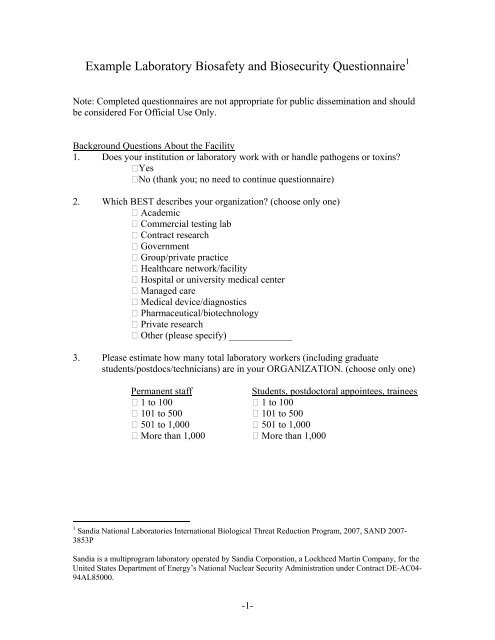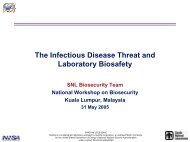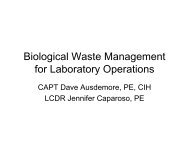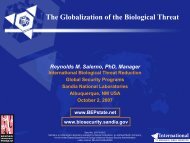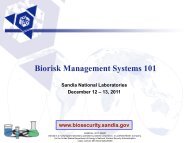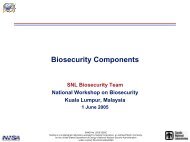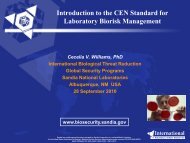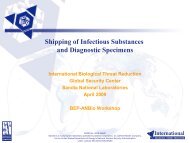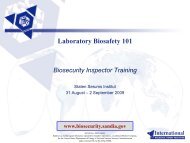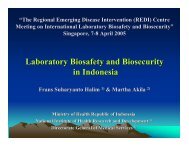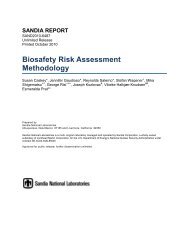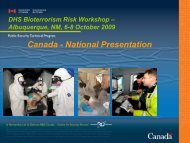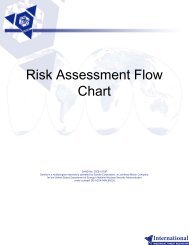Questionnaire - Laboratory Biosafety and Biosecurity - Sandia ...
Questionnaire - Laboratory Biosafety and Biosecurity - Sandia ...
Questionnaire - Laboratory Biosafety and Biosecurity - Sandia ...
You also want an ePaper? Increase the reach of your titles
YUMPU automatically turns print PDFs into web optimized ePapers that Google loves.
4. Which of the following BEST characterizes the stage of your laboratory’s workwith these infectious agents <strong>and</strong>/or toxins? Basic Clinical Disease surveillance Drug discovery <strong>and</strong>/or development Translational Other (please specify) _____________5. From where does your facility receive funding to conduct your bioscience work?(check all that apply) Local government My department My institution National government Non-medical corporation Pharmaceutical, biotechnological or diagnostic company Private foundation or charity Royalties State government Other (please specify) _____________6. Which biosafety levels (as described in the WHO <strong>Laboratory</strong> <strong>Biosafety</strong> Manual)best categorize the laboratories at your institution? (check all that apply) <strong>Biosafety</strong> Level 1 (BSL1 or P1) <strong>Biosafety</strong> Level 2 (BSL2 or P2) <strong>Biosafety</strong> Level 3 (BSL3 or P3) <strong>Biosafety</strong> Level 4 (BSL4 or P4) Don’t knowPathogens <strong>and</strong> toxins used or stored at the institution7. Bacteria <strong>and</strong> Rickettsia: Bacillus anthracis Bordetella pertussis Brucella abortus, melitensis or suis Burkholderia mallei Burkholderia pseudomallei Campylobacter jejuni Chlamydia psittaci Clostridium botulinumClostridium tetani Corynebacterium diphtheriae Coxiella burnetii Escherichia coli O157:H7 Francisella tularensis-2-
Hepatitis viruses A B C D E Human immunodeficiency virus (HIV) Influenza viruses H5N1 H2N2 contemporary human influenza virusstrains Other (please specify) _____________ Newcastle Disease virus (VVND) Nipah viruses Norovirus Polio virus Pox viruses Monkeypox virus Vaccinia virus Other (please specify) _____________ Rabies virus Rift Valley fever virus Rinderpest virus Severe Acute Respiratory Syndrome (SARS) Viral encephalitides Eastern Equine Encephalitis virus Japanese Encephalitis virus Kyasanur Forest virus Venezuelan Equine Encephalitis virus Western Equine Encephalitis virus West Nile Virus Other (please specify) _____________ Vesicular Stomatitis virus West Nile virus Yellow fever virus Other (please specify) _____________9. Toxins: Abrin Aflatoxin Botulinum toxins Clostridium perfringens toxins Conotoxin Diacetoxyscirpenol Microcystins-4-
Canada, <strong>Laboratory</strong> <strong>Biosafety</strong> Guidelines Australian/New Zeal<strong>and</strong> St<strong>and</strong>ard 2243.3 Safety in laboratories –Microbiological aspects <strong>and</strong> containment facilities <strong>Laboratory</strong> director(s) My country’s government Office International des Epizooties (OIE) Other (please specify) _____________ Our lab does not employ any specific laboratory policies or regulations.12. How does your organization manage its biosafety <strong>and</strong> biosecurity programs?(check all that apply) <strong>Biosafety</strong> manual or plan <strong>Biosecurity</strong> manual or plan <strong>Biosafety</strong> training Please specify what kind <strong>and</strong> how often: _____________ <strong>Biosecurity</strong> training Please specify what kind <strong>and</strong> how often: _____________ Health <strong>and</strong> medical surveillance Immunizations when needed Personnel screening St<strong>and</strong>ard Operating Procedures (SOPs) Incident response plans Institutional biosafety committee <strong>Biosafety</strong> officer or other person with responsibility for biosafety <strong>Biosecurity</strong> officer or other person with responsibility for biosecurity <strong>Laboratory</strong> management plan Protection of susceptible (e.g., pregnant, immunocompromised)employees Other (please specify) _____________ None of the above<strong>Laboratory</strong> <strong>Biosafety</strong>13. Which of the following aspects of biosafety does your institution use to managethe risks? (check all that apply) Practices & procedures (e.g. good microbiological techniques, PersonalProtective Equipment (PPE)) Primary barriers (e.g. biosafety cabinets) Secondary barriers (e.g. room construction, directional airflow) Please specify which of the above three is most important at yourinstitution: _____________-6-
14. Please indicate which types of biosafety features that your facility has.No YesPhysical isolation of laboratoryDouble-door entryAdequate lightingFire protection systemH<strong>and</strong> washing sink near lab exitAnteroomAnteroom with showerAbility to monitor peopleWindow(s)Closed-circuit televisionTwo-way communicationType of ventilationSt<strong>and</strong>ard building ventilationInward airflowRoom exhaust is single passHEPA-filtered air exhaustSealable room for decontamination-7-
15. Please indicate what proportion of the time your lab uses or performs thefollowing biosafety measures.Decontaminating wastebefore disposalAll ofthe timeMost ofthe timeSome ofthe timeLittle ofthe time Segregating waste Minimize use of sharps Dedicated sharpscontainers for disposal ofsharpsUse of Class I BiologicalSafety Cabinet for workwith infectious materialsUse of Class II, Type A1Biological Safety Cabinetfor work with infectiousmaterialsUse of Class II, Type A2Biological Safety Cabinetfor work with infectiousmaterialsUse of Class II, Type B1Biological Safety Cabinetfor work with infectiousmaterials Use of Class II, Type B2 Biological Safety Cabinetfor work with infectiousmaterialsUse of Class III Biological Safety Cabinetfor work with infectiousmaterialsGloves Double gloves whenh<strong>and</strong>ling infectiousmaterial Closed toes shoes Lab coats, lab gowns Noneof thetime-8-
N95 or N100 respirators Powered air purifying respiratorsMechanical pipetting aids <strong>Laboratory</strong> <strong>Biosecurity</strong>15. Please indicate what proportion of the time your lab uses or performs thefollowing physical security measures.Electronic access controldevicesGuard at buildingentrance(s)Intrusion sensors <strong>and</strong>alarmsAll ofthe timeMost ofthe timeSome ofthe timeLittle ofthe time Lighted building at night Locked cabinets Locked doors to building Locked doors to laboratory room(s)Locked refrigerators Security patrols Self-closing doors Unobstructed views of entrance(s)Video monitors Noneof thetime-9-
18. Please indicate what proportion of the time your lab uses or performs thefollowing material control & accountability measures.Appropriatepermission(s) obtained toshare infectious agents<strong>and</strong>/or toxins with otherinvestigators/labsCurrent inventory ofinfectious agents <strong>and</strong>/ortoxinsInventory records arechecked against actualinfectious agents instorageDirect supervisor isaware of all infectiousagents <strong>and</strong>/or toxinsstudied in labInfectious agents <strong>and</strong>/ortoxins not in use aredestroyed<strong>Laboratory</strong> head is awareof all infectious agents<strong>and</strong>/or toxins studied inlabShipment of infectiousagents <strong>and</strong>/or toxinsusing International AirTransport AssociationIATA Dangerous GoodsRegulationsAll ofthe timeMost ofthe timeSome ofthe timeLittle ofthe timeNoneof thetime -11-


